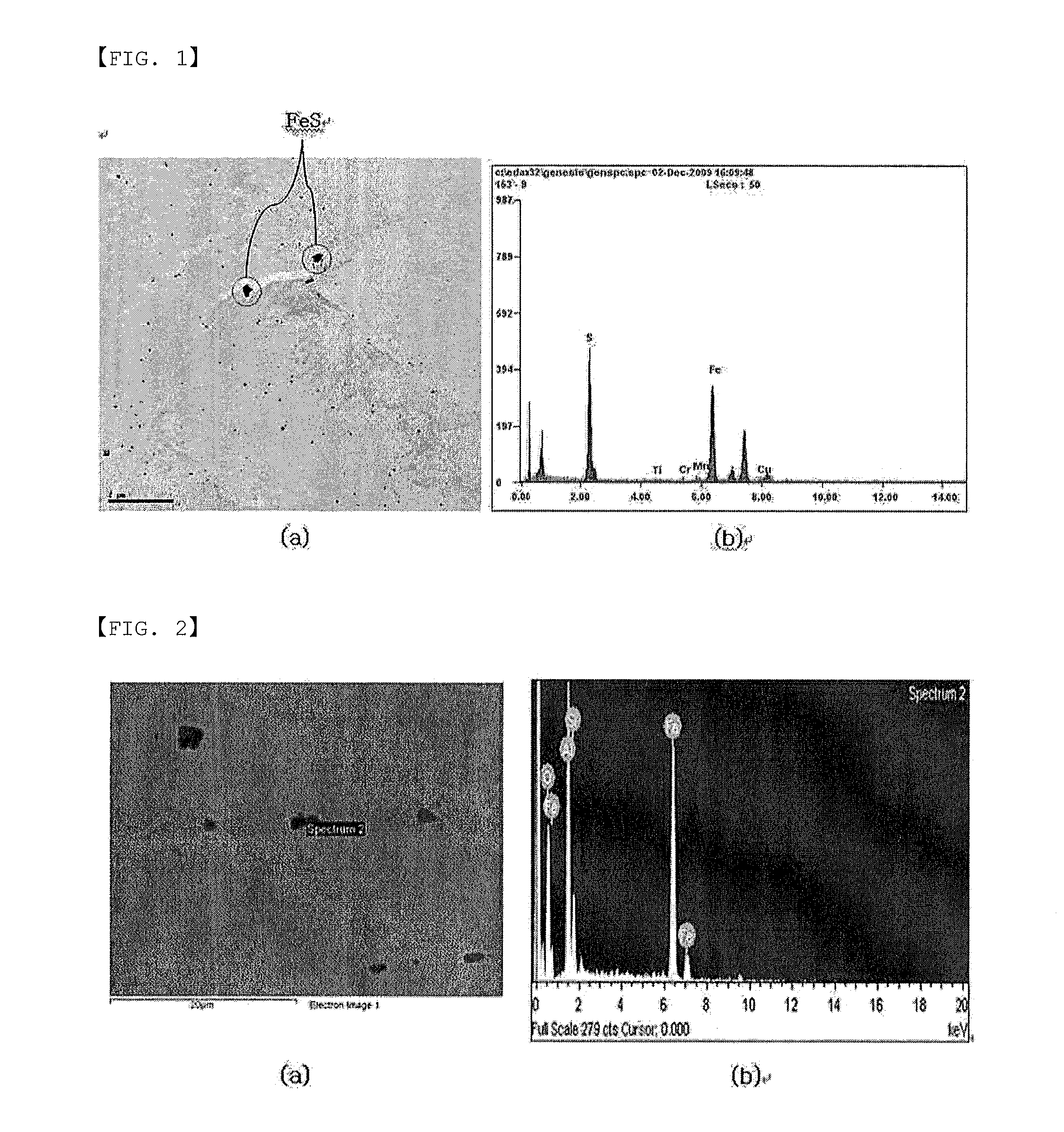Grain-Oriented Electric Steel Sheet Having Superior Magnetic Property and Method for Manufacturing Same
- Summary
- Abstract
- Description
- Claims
- Application Information
AI Technical Summary
Benefits of technology
Problems solved by technology
Method used
Image
Examples
example 1
[0066]Slabs comprising C, Si, Mn, S, Al and N in the amounts shown in Table 1 below and the balance of Fe and unavoidable impurities were melted in a vacuum to prepare ingots. Each of the ingots was heated to a temperature of 1250° C., and then hot-rolled to a thickness of 2.3 mm. The hot-rolled steel sheet was annealed by heating it to a temperature of 900° C., and then subjecting it to homogenization heat treatment for 180 seconds. Then, the annealed steel sheet was cooled, pickled, and then cold-rolled to a thickness of 0.30 mm. The cold-rolled steel sheet was subjected to decarburization and recrystallization heat treatment at a temperature of 810° C. for 180 seconds in a mixed gas atmosphere of wet hydrogen and nitrogen. Then, the steel sheet was coated with the annealing separator MgO and finally annealed in a coiled state. In the final annealing, the steel sheet was maintained in a mixed atmosphere of 25% nitrogen +75% hydrogen at a temperature of up to 1200° C., and in a 100...
example 2
[0071]Slabs comprising C, Si, Al and N in the amounts shown in Table 2 below, 0.010 wt % Mn, 0.015 wt % S and the balance of Fe and unavoidable impurities were melted in a vacuum to prepare ingots. Each of the ingots was heated to a temperature of 1250° C., and then hot-rolled to a thickness of 2.3 mm.
[0072]The hot-rolled steel sheet was annealed by heating it to a temperature of 1,100° C., and then subjecting it to homogenization heat treatment for 180 seconds. Then, the annealed steel sheet was cooled, pickled, and then cold-rolled to a thickness of 0.30 mm.
[0073]The cold-rolled steel sheet was subjected to decarburization and recrystallization heat treatment at a temperature of 830° C. for 180 seconds in a mixed gas atmosphere of wet hydrogen and nitrogen.
[0074]Then, the steel sheet was coated with the annealing separator MgO and finally annealed in a coiled state. In the final annealing, the steel sheet was maintained in a mixed atmosphere of 50% nitrogen+50% hydrogen at a tempe...
example 3
[0081]Slabs comprising C, Si, Al and N in the amounts shown in Table 3 below, 0.020 wt % Mn, 0.020 wt % S and the balance of Fe and unavoidable impurities were melted in a vacuum to prepare ingots. Each of the ingots was heated to a temperature of 1250° C., and then hot-rolled to a thickness of 2.3 mm.
[0082]The hot-rolled steel sheet was annealed by heating it to a temperature of 1,100° C., and then subjecting it to homogenization heat treatment at a temperature of 900° C. for 120 seconds. Then, the annealed steel sheet was cooled, pickled, and then cold-rolled to a thickness of 0.30 mm.
[0083]The cold-rolled steel sheet was subjected to decarburization and recrystallization heat treatment at a temperature of 850° C. for 180 seconds in a mixed gas atmosphere of wet hydrogen and nitrogen.
[0084]Then, the steel sheet was coated with the annealing separator MgO and finally annealed in a coiled state. In the final annealing, the steel sheet was maintained in a mixed atmosphere of 50% nitr...
PUM
| Property | Measurement | Unit |
|---|---|---|
| Temperature | aaaaa | aaaaa |
| Time | aaaaa | aaaaa |
| Time | aaaaa | aaaaa |
Abstract
Description
Claims
Application Information
 Login to View More
Login to View More - R&D
- Intellectual Property
- Life Sciences
- Materials
- Tech Scout
- Unparalleled Data Quality
- Higher Quality Content
- 60% Fewer Hallucinations
Browse by: Latest US Patents, China's latest patents, Technical Efficacy Thesaurus, Application Domain, Technology Topic, Popular Technical Reports.
© 2025 PatSnap. All rights reserved.Legal|Privacy policy|Modern Slavery Act Transparency Statement|Sitemap|About US| Contact US: help@patsnap.com

